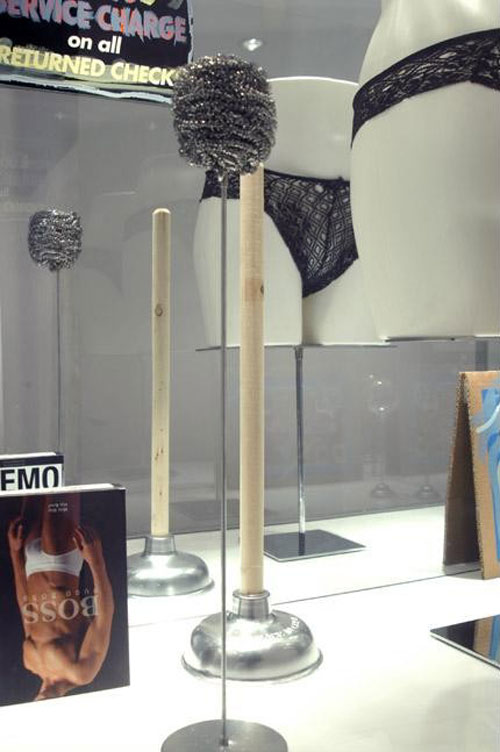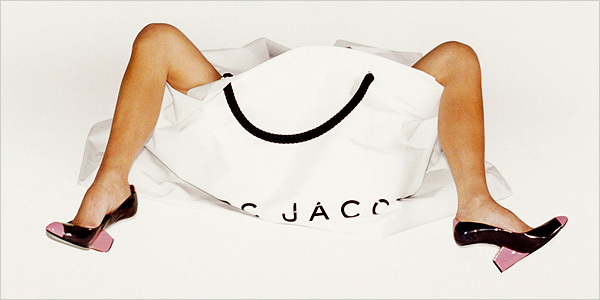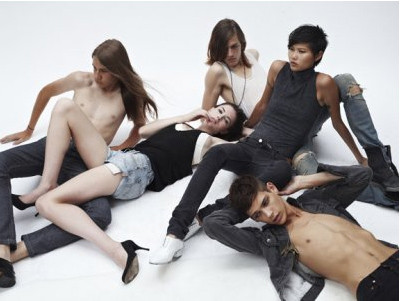SEPARATING THE ART AND fashion worlds from each has become increasingly difficult in contemporary culture: fashion, which has long been a borrower of imagery from art, is also used as material for artists to critique the commercial and social values it represents. With fashion being the thriving image marketplace that it is, there is always an abundance in appropriated or re-contextualised images. Inversely, if we look at this process from the perspective of the art world, there is increasing use and reference to the fashion image, which often has a more critical effect. Ultimately this results in an increasing ambiguity of material in the visual landscape, and therefore difficulty in identifying whether we are looking at a fashion image critically, or adoringly. Furthermore, the artist as a fashion figure, is prevalent, blurring these distinctions of values even further.
Fashion is a complex symbol of consumption, ego and beauty; but simultaneously it is also pleasurable to consume, so it is highly potent in an art context. The three-dimensional collage of New York-based artist Josephine Meckseper is one of many personifications of this canon of work. Her work vividly comments on commercial layers of consumer culture by presenting disembodied fragments of sculpture and photography, which act like snapshots of gestures from everyday life. So fashion imagery is used as this sort of double-edge sword, such as in ‘Talk To Cindy’ (2005) which depicts a vitrine filled with knick knacks; a portion of an underwear-clad mannequin, an upside-down box of men’s Calvin Klein underwear, and other domestic artefacts; steel wool, found text and a toilet plunger suggestively hint at smut, but in a sterile way. In this work, the pleasure of consuming the fashion image or aesthetic, at least in fragments, is still functioning, yet re-contextualised in an art framework. Other artists, for example, Richard Philips, Erwin Wurm and K8 Hardy (a contributor to Vestoj‘s On Fashion and Power), to name only a few, whose work – in varying ways – often engages with the fashion image to a similar degree of popularity. Meckseper’s own reputation has been solidified by recent shows at the Parrish Art Museum, NY, and features across fashion and art publications, for example, Interview magazine.1

Inversely, looking at an artist from the fashion side of things, Juergen Teller is a classic example. Very much operating within the fashion framework (but also as an artist), insofar as he is a fashion photographer, yet after the seasons and magazines have passed, his fashion images are sold as artworks and exhibited in galleries. In working in this way, Teller offers fashion the sort of enduring integrity, or ‘coolness’, that is associated with art. His 2008 series for Marc Jacobs collection campaign with Victoria Beckham, received mainstream attention when he presented Beckham literally as a fashion product, or a product of fashion, when he photographed her in the Marc Jacobs shopping bag. As Teller recalls to Cathy Horyn for The New York Times his conversation with Beckham of the clothes-less image; ‘[…] fashion nowadays is all about product — bags and shoes — and you’re kind of a product yourself, aren’t you?” She was, like, “Uh, yeah.’2

Likewise we see this duality between critique and engagement with the fashion image in the work of the New York-based collective Bernadette Corporation. The one-time fashion label, publication and art collective’s popularity has been solidified by their recent exhibitions at the Institute of Contemporary Arts in London, and Greene Naftali Gallery in New York. The Corporation (core members include: John Kelsey and Bernadette Van-Huy) have a body of work that delves deep into the structure of a fashion company, creating actual fashion shoots that offer both a critical output, whilst also engaging with the fashion industry. For the photo series ‘Is Everybody on the Floor’ (2009) they recreated a Levis fashion shoot from the 1990s with photographer Jason Mandella, and their show at the ICA featured fashion mannequins in ensembles of cheap taste, references to tattoos, fur, gold jewellery shaped into awkward outfits, which in the gallery context had a surreal effect. The Bernadette Corporation offers a complex critique of the fashion system, and of capitalism, but they are working in a way in which their aesthetic is so dependant on the desirability of the fashion image that it is at risk of moving away from critique. As they explained in an interview with Kaleidescope magazine, ‘Fashion was interesting to us originally because it already operated across all these sectors, across all media. […] It was both a system and an image, and it moved very quickly.’3 But perhaps it is possible to have the best of both worlds, to simultaneously engage with fashion and to keep at the hostile distance of criticism, in avoiding this ‘one or the other’ duality. As Jason Farago writes in his review of their ICA show, ‘Although the label set out to expose the fashion industry’s appropriation of downtown (often immigrant) subcultures, it was also a bona fide brand, covered everywhere from i-D magazine to The New York Times, and noted for recklessly mixing high and low end looks in single items.’4

Moreover both these worlds have merged in a complex landscape of visual communication; galleries host fashion shows; artists work as designers, all with weighty PR teams behind them ensuring coverage in the realms of both digital and print. But it is certainly popular for artists to engage with fashion; suggesting that critiquing consumer culture is ‘fashionable’. In the social pages of Purple magazine Josephine Meckseper appears mingling with other influencers and hand-picked cultural figures we are recommended to aspire to, suggesting that art is very much ‘in fashion’.
Laura Gardner is Vestoj’s former Online Editor and a writer in Melbourne.
Josephine Meckseper interviewed by Liam Gillick for Interview magazine, http://www.interviewmagazine.com/art/josephine-meckseper/#_ ↩
Cathy Horyn for The New York Times, ‘When is a Fashion Ad not a Fashion Ad?’, 2008 http://www.nytimes.com/2008/04/10/fashion/10TELLER.html?pagewanted=all ↩
Bernadette Corporation interviewed by Annie Ochmanek for Kaleidescope magazine, http://kaleidoscope-press.com/issue-contents/bernadette-corporation-interview-by-annie-ochmanek/ ↩
Jason Farago for The Guardian, ‘Bernadette Corporation: “Don’t have sex with each other”‘, 2013 http://www.theguardian.com/artanddesign/2013/mar/24/bernadette-corporation-ica ↩